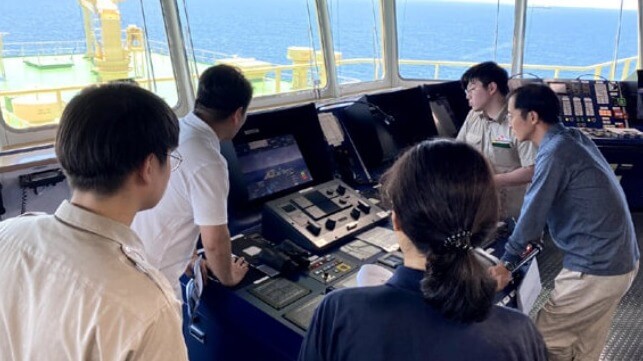Koreans Lead Program to Commercialize Level 2 Autonomous Ships in 2023

Autonomous shipping using artificial intelligence and other technologies first to assist with navigation and ultimately to take command of ocean-going ships continues to make progress. While most of the systems currently available are only providing decision support to the bridge crew, a partnership led by South Korea’s Hyundai Heavy Industries expects to commercialize a second-level system with autonomous control supervised by an onboard crew by July 2023.
“We are focusing on research and development for autonomous navigation, and some of our technologies have already been commercialized, taking the lead in the global market,” said Won-ho Joo, HHI Senior Executive Vice President & Chief Technical Officer. “As a pioneer in the autonomous ship sector, we will advance our technologies through various collaborations with other market leaders.”
HHI and its subsidiary Avikus are leading the development of the company’s autonomous systems. They have conducted a series of successful demonstrations, including in May 2022 the company’s systems controlled a 97,500 dwt LNG carrier for roughly half its voyage across the Pacific, or approximately 5,400 nautical miles avoiding over 100 ships and optimizing the voyage.
The company has now entered into an agreement to collaborate for the commercialization of the next-generation system known as HiNAS 2.0. HHI will be working with Korean Register and the Liberian Registry (LISCR) to commercialize autonomous navigation technology. The agreement calls for HiNAS 2.0 to be ready to be installed on KR classed and LISCR registered ships in July of next year.
HiNAS 2.0 uses artificial intelligence to recognize the surrounding environment, such as weather and wave heights, and nearby ships, and then goes beyond providing simple information and controls the vessel's steering commands and speed in real-time to avoid collision risk. The system uses augmented reality to guide optimal routes. The solution was developed for increasing fuel efficiency and ease the operational burden on bridge teams.
“While autonomous navigation technology is gradually advancing from smart ships to autonomous ships and then to unmanned ships, the agreement signed today is a new milestone in the transition of the technology,” said Kyu-jin Yeon, Head of KR’s Plan Approval Center.
Commercial systems on the market today provide a ship with automated processes and decision support is referred to as Level 1 in the categorization of the technology by the IMO. HiNAS 2.0 is aiming to be the most advanced solution of the existing autonomous navigation systems at Level 2 where a ship is controlled by the system with seafarers on board to monitor its progress.
Several short sea projects such as the Yara Birkeland are working toward certification of the more advanced levels of automation defined by the IMO. Their goal is to reach certification within two years becoming the first in the world to operate at levels 3 or 4. Level 3 is defined as the ship being remotely controlled without any seafarers on board, and with Level 4, the ship is fully autonomous.
The Japanese shipping industry, with the support of its government, is also rushing to develop and demonstrate advanced levels of autonomous shipping. Early in 2022 a series of demonstrations were conducted using containerships and ferries to highlight Japan's advancements in autonomous shipping. In addition to navigation for ocean-going vessels they demonstrated systems that dock and undock ships.
